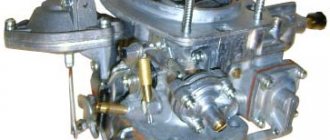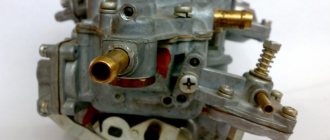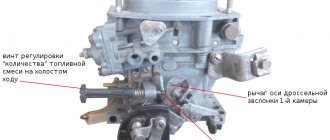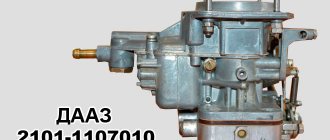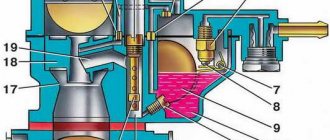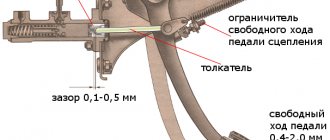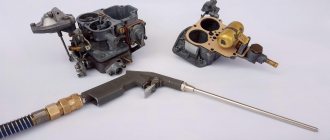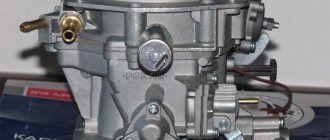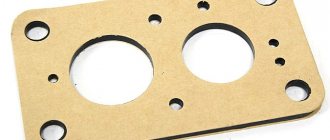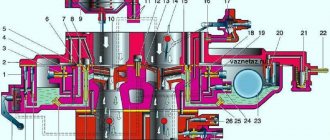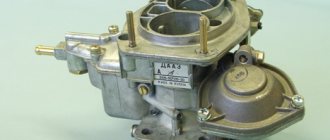Device
The DAAZ carburetor, developed by analogy with the product of the Italian brand Weber, is designed to dose the gas-air mixture in all engine operating modes without the participation of electronics. It consists of three main parts:
- covers with semi-automatic starting system;
- main or middle block with camera;
- additional or lower block with throttle valves.
The device cover includes important parts of the carburetor: flaps, a fitting for connecting a gasoline supply hose, a filter mesh, a needle float, an econostat tube, and an accelerator pump. The upper part of the carb is connected to the main block using several screws (M5).
The middle block consists of the main chamber, diffusers, jets, and a sprayer (helicopter). All the necessary channels responsible for certain engine operating modes are installed here.
The lower or additional block is equipped with throttles and adjusting screws, thanks to which it is possible to adjust the quality and quantity of the sprayed combustible mixture. There are also many different output channels available here. Like the upper part, it is connected to the main unit via screws.
It is easier to consider the carburetor design by looking at the operation of individual subsystems:
- A special place in the carburetor is occupied by the starting device system or SPU. It comes into operation when the engine starts. It is activated due to the vacuum created as a result of the movement of the cable when the diffuser opens. The SPU closely interacts with the gas pedal;
- Idle system. Its functions are clear by its name. On Weber it is of the classic type, on Ozone it is autonomous and works independently of the carburetor. On standard systems there is a special calibration screw that adjusts the throttle or air. It makes it possible to increase or decrease the number of idle speeds. There is also a mixture quality screw located in a different place, in a recess. By rotating it, you can supply the engine with exactly the amount of gasoline it needs;
- A transition system responsible for a smooth transition from idle to operation of the main jets. There is also a separate jet, which can also be attributed to this system. It stabilizes engine operation at high speeds;
- Main metering system based on the operation of the emulsion tube, fuel nozzle and chokes. It is in this mode that it is possible to open both throttles and the maximum speed of the car;
- Accelerator pump system. It controls the mixture, preventing air from entering more than normal. This makes it possible to avoid throttle failures during sudden car starts from a standstill and other maneuvers;
- Econostat that increases engine thrust at maximum speed. Consists of three jets: fuel, emulsion and air;
- A float mechanism system that maintains a constant fuel level in the chamber. Equipped with an adjustable needle valve. When the fuel in the chamber decreases, the float moves down, the valve opens and gasoline from the tank begins to flow through the fitting.
Jets
For some reason, the instructions categorically do not recommend increasing the jets, but the risk is justified and in some cases the improvements are obvious.
Of course, it is dangerous to immediately change all existing combinations at once, so changes should be made gradually. So, the primary camera:
- GTZh (main fuel jet) - 125.
- GVZh (main air jet) - 150.
We leave the secondary camera as is and check it. Acceleration will be better.
Let's move on to the second chamber:
- GTZ - 162.
- GVZh - 190.
The result of the changes will be a feeling as if the gas pedal is pressed until the secondary chamber opens and the turbo is turned on, while the engine easily spins up to 6000–6500 rpm. Fuel consumption may increase slightly. This is due to the fact that, when moving around the city, you will not accelerate strongly at traffic lights every time, so you will be able to save gasoline only on the highway or in the case of empty city roads.
If you approach tuning your original five wisely, you can refine it to excellent condition. The car will serve you for many more years and will delight you with its improved characteristics.
Sources
- remam.ru/tune/tyuning-karbyuratora-vaz-2105.html
- ladaautos.ru/vaz-2105/kak-delaetsya-regulirovka-karbyuratora-vaz-2105.html
- carnovato.ru/karbjurator-zhiklery-vaz-2105/
- drive2.ru/b/2232459/
- swapmotor.ru/ustrojstvo-dvigatelya/karbyurator-vaz-2105.html
- bumper.guru/klassicheskie-modeli-vaz/toplivnaya-sistema/karbyurator-vaz-2105.html
Modifications of carburetors installed on the VAZ 2105
On the “five” or VAZ 21053, 3 types of carburetors can be installed. All models are supplied in an unfinished form. Let's look at how they differ from each other.
DAAZ
The DAAZ or Weber carburetor is probably the sportiest type of carburetor, as it is equipped with large and maximally open, non-clamped jets. Car service experts say that this model is affordable and very reliable. There are no unnecessary bells and whistles here. With it, the car starts perfectly, drives well, and the idle system is easier to adjust.
These models are produced by the Dmitrov Automotive Aggregate Plant under license from Weber. The disadvantages include high fuel consumption. Theoretically, if Ozone consumes 7 liters of gasoline, then DAAZ consumes all 8.5 liters. In practice, DAAZ carburetors, especially used ones, can consume up to 14-15 liters of fuel per 100 km.
"Ozone"
An improved model of the old, classic DAAZ. It received the name “Ozone” due to its environmental friendliness, because a perfectly tuned carburetor of this type allows you to reduce gasoline consumption to 7 liters per 100 km.
The downside of Ozone is its complex design, which often leads to problems with the secondary chamber. This malfunction is associated with the fact that the additional camera is activated not mechanically, as on Webers, but using a pneumatic valve. Also, Ozone carburetors are highly sensitive to contamination. As a result, the adjustments are disrupted, the second chamber begins to open with a delay or does not close completely. What does this lead to? Acceleration dynamics deteriorate, engine output decreases, and maximum speed decreases.
"Solex"
Licensed products from Solex. A carburetor of this type has proven itself on the VAZ 2105, 21054 and other classics only on the good side. It turned out to be economical and at the same time dynamic. The design is completely different from DAAZ. There is a “return” - a fuel return supply system, as well as a number of additional auxiliary electronic systems.
Thanks to the reverse supply system, excess gasoline re-enters the tank. This makes it possible to save almost 1 liter of fuel per 100 km, which is very good. The autonomous neutral speed system, equipped with electrical adjustment, has proven itself well. There is also a separate cold start subsystem.
Despite such advantages, the Solex carburetor, especially found in the CIS, turned out to be somewhat problematic. For example, the fuel channels on it quickly become clogged, since they are narrow. If this model is not serviced in a timely manner, failures in the neutral system will begin.
In some cases, a carburetor of a non-standard or non-standard type may be installed on the “five”. This installation requires certain modifications followed by proper adjustment. For example, such options are carburetors 21073 and 21083.
Carb from 2105 to 2107
- Please log in to reply.
#1 Jasper
- Users
- 34 messages
- Registration 13-January 07
- Top
- Complaint
#2 lightix
Jasper, a similar situation was on the Cosmic 2140 with a 1.5 liter engine, people bought it and installed an ozone-2105 carburetor, which choked the engine and caused high fuel consumption, because... The carburetor is designed for engines up to 1.3 liters. The issue was resolved by selecting jets and installing a mechanical drive for the second chamber. I can’t say right now what exact combinations of jets were right, it was a long time ago. And you can’t guess here, you have to try to select it for a specific engine and specific tasks. I remember exactly that the games were with jets that were in the carburetor and jets corresponding to the 1.5l engine.
The dynamics turned out to be excellent, consumption was normal.
- Top
- Complaint
#3 lightix
- Top
- Complaint
#4 AnSansey
Jasper, a similar situation was on the Cosmic 2140 with a 1.5 liter engine, people bought it and installed an ozone-2105 carburetor, which choked the engine and caused high fuel consumption, because... The carburetor is designed for engines up to 1.3 liters. The issue was resolved by selecting jets and installing a mechanical drive for the second chamber. I can’t say right now what exact combinations of jets were right, it was a long time ago. And you can’t guess here, you have to try to select it for a specific engine and specific tasks. I remember exactly that the games were with jets that were in the carburetor and jets corresponding to the 1.5l engine.
The dynamics turned out to be excellent, consumption was normal.
How to properly adjust the carburetor on a VAZ 2105: detailed instructions
A correctly configured carburetor very accurately doses the combustible mixture. For example, the difference between the fuel-air mixture intended for idling the engine and the fuel for cold starting of the internal combustion engine is almost 20 points. Therefore, adjustment of the DAAZ 2105 carburetor or its Zhiguli analogue must be carried out and done skillfully as soon as high fuel consumption or unstable engine operation is detected.
In principle, the process of setting up a VAZ 2105 carburetor is not that complicated. Even a beginner can handle the job, but he has studied the device and the sequence of necessary operations. Before making adjustments, it is extremely important to make sure that the OZ is set correctly. It is necessary to check the condition of the distributor cover, breaker contacts, spark plugs and high-voltage wires.
Idle adjustment
If the idle speed is not adjusted correctly, the engine will suddenly stall, stall, “fail” during acceleration, and consume a lot of fuel. It is advisable for beginners to use the tachometer data; experienced carburetor operators determine incorrect speeds by ear. You will also need a 3mm slotted screwdriver.
Adjustment of the VAZ 2105 carburetor in neutral mode is carried out with the engine running and warmed up to operating condition. First you need to make sure that the main dosing system is not working (it should not be activated in this mode). Look from above, through the throttle holes - fuel is pouring or the chambers are dry. If fuel is supplied, then the XX system requires proper configuration.
Further actions:
- use a screwdriver to increase/decrease the speed of the adjusting screw;
- if the system does not respond to the screw, unscrew the idle jet a few turns, creating a vacuum and thereby clearing this very channel from blockages;
- then adjust the fuel quality screw - as you tighten it, the speed drops and vice versa (the notorious “slide”);
- Now adjust the mixture quantity screw.
As a rule, these actions are enough to normalize the operation of the idle system. The jet can become clogged, and the technique of creating an air vacuum without completely unscrewing the element will help clean it.
“Hump” is a normal condition of the carburetor, in which fully tightening the mixture quality screw leads to the engine stopping or reducing the speed to an unacceptably low level. And with the maximum enrichment of the mixture with the emulsion - unscrewing the nozzle, a decrease in speed should also occur, but for other reasons. In this case, the mixture becomes excessively rich and burns worse. There may even be black smoke coming from the muffler. Thus, checking the carburetor “slide” allows you not only to determine the quality of the mixture, but also at the same time to test the compliance of the fuel nozzle of the XX system with the condition of the carburetor and engine.
Now let's talk more about calibration. On a carburetor that has lost its settings, it is customary to first set the original speed values. To do this, tighten both screws (quality and quantity of the mixture) until they stop. Then lower the quality screw by 3 turns, and the quantity screw by 4 turns.
- increase the gasoline supply by rotating the quality screw counterclockwise;
- increase the total amount of fuel mixture by unscrewing the amount screw;
- check with the mixture quality screw whether the set XX speed is correct - when turning the quality screw, the engine speed should rise to 850-900 per minute, which is the ideal idle value.
1 — throttle screw; 2 — adjusting screws for mixture quality; 3 - screwdriver
The correct RPM mark should be exactly between the zones when the engine stalls when tightening and unscrewing the mixture quality screw. You can find it this way: tighten the screw in one direction until the motor starts to stall. Mark the position on the screwdriver shaft - for example, with red paint. Then turn the screw back, counting the number of revolutions until the engine starts to stall again. Align the screw in the middle: if, for example, there were 8 total turns from edge to edge, then the middle will be 4 turns.
If the idle speed cannot be adjusted using the steps described above, one of the following reasons is likely:
- the fuel and air channels of the main carburetor system are clogged;
- the camera jets are swapped;
- the needle valve is faulty;
- tubes have come off the pneumatic valve (“Ozone”);
- The oil seal of the mixture quality screw has dried out.
Eliminating failures in engine operation during acceleration
“Failure” in this case - the Zhiguli car first bites the front end, and only then begins to gain momentum. There may be several reasons: the “fan” or “beak” is clogged, the accelerator pump system is incorrectly configured.
As a rule, any theorist will start checking with the accelerator pump system, especially on Ozone models, since it is responsible for stabilizing the engine during acceleration. In practice, carburetor technicians who have deep knowledge in this area can check other points first (so as not to remove the device again). However, this is not the point, and the acceleration system must be checked and adjusted in case of problems.
The integrity of the acceleration system is tested with the carburetor removed. Here are the elements that need to be checked carefully:
- clogging of the bypass and inlet holes of the float chamber - the accelerator pump comes into contact with it;
- condition of the bypass nozzle;
- integrity of the diaphragm, its reliable and tight fastening;
- free play of the diaphragm spring;
- tightness of the connection between the cover and the body of the carburetor starting device;
- pump valve performance;
- condition of the sprayer, correctness of the spray jet.
One of the signs of a system malfunction, specifically a broken diaphragm, is gasoline leaking through the accelerator cap. This symptom can be detected even on the car, with the carburetor installed and the fuel system connected to it.
A smooth and good stream of gasoline is the key to trouble-free operation of the carburetor acceleration system. Spraying in this mode must have a strictly correct direction - exactly between the wall of the diffuser and the body of the “helicopter” (on Ozons this is extremely difficult to achieve due to the cast, inactive nose). The mixture should not touch anything, otherwise it will not be enriched, and this is a prerequisite for dynamic acceleration of the car. Also, all connections of the metering device must be sealed, without any leakage of fuel.
Also, the cause of failure is incorrect adjustment of the bolt of the second carb chamber.
Here's what to do:
- Use tongs or pliers to tighten this bolt, closing the secondary chamber of the carburetor;
- start the engine;
- press the gas pedal all the way - dips will be clearly noticeable in idle mode;
- unscrew the adjusting bolt until the neutral speed starts to rise;
- adjust the XX system with screws for the quality and quantity of the mixture;
- check for failures - repeat the procedure if necessary.
On Solex carburetors, the cause of failures during acceleration can be simple clogging. Here's what to do:
- remove the top of the carburetor;
- unscrew both emulsion tubes;
- blow out the jets installed inside the channels with a cleaner, as well as all visible overflow holes;
- also blow out the accelerator nozzle;
- adjust the rise of the floats;
- replace the carburetor top cover gasket;
- Remove and clean the coarse filters.
If the candles flood
It happens that DAAZ and Solex carburetors flood the spark plugs when starting a cold engine. The engine does not start or stalls after a while. This indicates an overly rich mixture, which may be caused by a faulty accelerator diaphragm. And it is precisely responsible for the reliable start-up of a cold internal combustion engine, providing a flow of air into the chamber.
It is advisable, before checking the carburetor directly, to exclude all other causes of flooding of spark plugs. And this can happen due to faulty spark plugs or a fuel pump (pumping) and severe frost, which affects poor fuel volatility.
There are several types of damage to the diaphragm:
- crackling;
- delamination;
- the appearance of scuffs and holes.
It is clear that to correct the situation it is necessary to replace the diaphragm:
- Unscrew the 4 cover bolts with a screwdriver;
- Unscrew the middle bolt with a size 8 wrench;
- separate the lid;
- pull out the spring, then the diaphragm with the rod;
- install a new part;
- assemble everything in reverse order;
- adjust the carburetor starter.
In addition to the diaphragm mechanism, at the same time it is necessary to check the housing of the starting device for leaks. Clogging of the air jets of the main dosing system is no exception.
It is also recommended to check the condition of the float chamber needle valve. It may be worn out or deformed, and thus lead to an over-rich fuel mixture. In this case, spark plugs will also be poured onto a hot engine.
Checking the shut-off needle valve on Solex carburetors should be carried out with the fuel supply fitting closed and the metering device cover in a strictly horizontal position.
If there is a smell of gasoline in the car interior
One of the reasons for the strong smell of gasoline in the car interior may be a faulty or incorrectly adjusted carburetor. This happens due to leaky connections. For example, leaky economizer and accelerator diaphragms, loosely tightened caps, or poorly secured parts of the metering device often leak fuel. Typically, a fuel leak can be easily determined visually. Another reason is play in the fuel supply and return passage fittings.
As for incorrect adjustment, it may be due to the needle valve that pours gasoline into the float chamber. As a result, the fuel level rises, the float touches the walls and fuel begins to flow out from under the lid or the gas pump nozzles in the diffusers.
All the “culprits” for the appearance of the smell of gasoline in the car interior are shown in the photo.
The car suddenly loses speed
This is the same failure discussed above. It is customary to distinguish several types of this unpleasant symptom. More details in the table below.
We clean the jets
Clogged jets are a common problem that leads to a car losing traction and its original technical characteristics. This is the reason for increased fuel consumption and other unpleasant issues.
The performance of these carburetor elements directly depends on the size of the hole and the length of the channel. But that's not all. It turns out that the roughness of the inner surface of the tube, as well as the change in pressure at the inlet and outlet, is also of great importance. Any unevenness will noticeably worsen the throughput, but it will be extremely difficult to determine the degree of smoothness by eye.
Thus, clogged channels reduce their performance. Therefore, any owner of a carburetor car should have a can of cleaning spray or carb cleaner on hand. You also need to have a convenient tool for removing jets and tubes, since by removing them you can carry out cleaning much more efficiently.
Carbcleaner liquid acts no earlier than 5 minutes after application. During this time, the composition will react with contaminants, soften them and wash them away. After this, you can start the engine to check, preferably using a choke. If the jets have not been cleaned for a long time, the cleaning procedure must be repeated several times.
In severe cases, when surface cleaning does not help, it is recommended to dismantle the carburetor. Before this, you can make preparations: swap the two high-voltage spark plug wires and start the engine. It will start to work terribly “sneezing” and “shooting”, which will help to automatically clean out deposits from the canals. After this, the dosing device is removed, the channels and chambers are thoroughly cleaned with carb cleaner or other means. In particularly difficult situations, the channels are drilled out and then washed.
Maintain your car's carburetor regularly. The cleaned jets will “revive” the dosing device, and the machine will start running like a clock.
Table: types of failures and solutions
| Type of failure | Recommended Actions |
| The failure is short-term (1-2 seconds), occurring when the accelerator is smoothly applied during the start of the car or at idle. Acceleration and dynamics of the car are normal. | Clean the output channels of the carb transition system or check the operation of the accelerator. |
| A series of failures with a possible engine stop, occurring at low and medium speeds. And when accelerating, the twitching disappears. | Clean the fuel jet of the main metering system; tighten the fuel nozzle of the main metering system of the first carburetor chamber a few turns; blow out the channels, the emulsion well with the emulsion tube of the main metering system of the first carburetor chamber; replace the fuel nozzle of the main metering system of the first chamber if its marking does not correspond to the required one; check the fuel level in the carburetor float chamber, exclude unauthorized air entry into the carburetor, check the operation of the choke; replace or clean the strainer at the carburetor inlet. |
| Failure or rocking (a series of failures) combined with unstable engine idle. | Clean the fuel nozzle of the idle system and the channels of the idle system; replace the solenoid valve or check the EPH system; replace the solenoid valve O-ring; Tighten the idle air system fuel nozzle holder more tightly. |
| Failure or swaying under high load conditions when driving with the throttle valves of both chambers open, combined with loss of power and throttle response. | Check the carburetor econostat and power mode economizer; clean the channels, jets, emulsion well with the emulsion tube of the main metering system of the second chamber of the carburetor; check the opening of the throttle valve of the second chamber of the carburetor; Check the fuel supply to the carburetor. |
| Failure when you sharply press the gas pedal at idle, when starting from a stop, accelerating and moving the car at different speeds. | Replace the accelerator pump, check the fuel level in the carburetor float chamber. |
If you have any questions, leave them in the comments below the article. We or our visitors will be happy to answer them
Expert advice
After completing the procedure for adjusting the VAZ-2105 carburetor device, experienced auto mechanics recommend paying attention to the following critical points:
- Valve location - is in the retracted position, with the idle speed jet touching the seat in the carburetor body.
- Lubricating the rubber seal with special motor oil.
- The location of the air damper intended for cold passage is in a vertical plane, while the suction handle is lowered.
- The condition of the solenoid valve - the presence of damage and malfunctions is checked as follows:
- turn on the ignition;
- remove and put the connector on the valve;
- listen to the sounds coming from the solenoid valve.
If clicks are heard during the inspection process, the part is in full working order.
Common causes of floating revolutions
So, we figured out the main symptoms. Now let's move on to the reasons. Let us immediately note that floating idle speed is often a problem with injection engines. The fact is that a complex ECM system is responsible for idling in this case.
This system assumes the presence of a controller, sensors and actuators. The control unit receives signals from sensors and transmits commands to actuators (for example, IAC), maintaining stable engine speeds at idle and other modes, regardless of the load on the internal combustion engine.
However, any failures that are associated with the supply of air, fuel, a violation of the composition of the working fuel-air mixture or its ignition, as well as various mechanical breakdowns will lead to floating speed.
As a rule, in practice, the idle air regulator causes a lot of problems for drivers. In fact, this is a stepper motor that has a conical locking needle. When the throttle valve is closed, air bypasses the valve through a channel that is closed by the needle.
If malfunctions occur in the operation of the device, the ECU is not able to correctly “select” the mixture composition at idle, as a result, the speed floats.
The mass air flow sensor also deserves special attention. During operation, the air flow sensor may become dirty or break down.
Throttle manipulation
First, remove the springs from the carburetor primary chamber throttle vacuum actuator. These actions will allow you to immediately feel the improvement in car dynamics while driving; fuel consumption per 100 km will increase by less than a liter.
By modifying the carburetor on the Lada 2105, you can increase power and dynamics
Refinement of the VAZ-2105 carburetor also involves replacing the vacuum drive of the secondary chamber throttle valve with a mechanical one. It's not as difficult as it seems.
To do this, take a small piece of straight wire and bend it into a ring at one end, push it under the nut that holds the throttle drive lever of the second chamber.
As a result, the protrusion of the outer chamber arm should be between the wire and the second drive arm. Tighten the nut firmly.
These simple tuning steps for the VAZ-2105 carburetor will improve dynamics, while fuel consumption will remain the same.
The following problems are also possible:
- Excessive (low) gasoline level in the float chamber.
- The air filter is clogged (here you can save yourself with a regular replacement).
In modern cars with an injection engine and electronic fuel injection, such as the VAZ 2110-2115, no less reasons can be identified. In this case, problems are often associated with the breakdown of one of the sensors.
What happens? The electronic control unit tries to read information and does not receive it. As a result, malfunctions in the operation of the power unit appear, and instability in speed appears.
But let's highlight all the main reasons. There are several of them:
- Problems with spark plugs (poor quality, wear, contamination);
- interruptions in the air supply (failure of the mass air flow sensor);
- air intake from outside into the intake system;
- damage (defect) of high-voltage wires;
- failure of the XX regulator;
- EGR sensor malfunction.
When the idle speed is floating, the first thing to do is check the idle speed control. Most often it is located next to another sensor that controls the throttle position. Checking is carried out using a multimeter.
If the sensor resistance is outside the normal range (40-80 Ohms), then there is a high probability of IAC failure.
If everything is normal with the idle speed control, you can move on to the next “suspect” - the mass air flow sensor.
To check the device, you need to disconnect the connector from it and start the engine. In this case, the engine speed will be around 1,500 rpm. If the dynamics only improve while driving, then the mass air flow sensor is really faulty.
The EGR valve is responsible for the movement of exhaust gases. The sensor's task is to return some of the gases back to the combustion chamber. This is necessary to ensure complete combustion of fuel and minimal harm from exhaust gases. Cleaning the valve seat is often enough to fix the problem.
3. In diesel cars, the cause of floating idle speed may be the appearance of corrosion on the moving blades in the power pump. As a result, they simply jam and stop coping with their function.
To prevent this from happening, you need to add at least a little motor oil to the fuel tank (200-250 grams is enough). This is enough to protect the metal elements with a thin layer of oil.
Now floating idle speeds will not cause you to panic, because you know what causes them and what needs to be done. Good luck on the roads and of course no breakdowns.
Setting the needle valve opening
Turn the carburetor cap over so that it is positioned vertically. In this case, the tail of the float should lightly touch the needle ball. Please note that even partial overlap is not allowed. Measure the distance using a paper template. Determine the distance from the plane of the float to the gasket on the carburetor cover. It should be no more than 6.5 mm. If it is larger or smaller, then adjust in the desired direction by bending the small tail on the float. The distance to the maximum degree of valve opening is measured in the same way.
Basic mechanisms and systems
To perform its functions, the carburetor has the following systems and mechanisms:
- System for maintaining the required fuel level;
- System for starting and warming up a cold engine;
- Idle system;
- Main dosing system;
- Acceleration pump;
- Econostat system.
Good old VAZ: love for life The three systems listed first in the list are subject to configuration. The VAZ 2105 carburetor in question can be adjusted without removing it from the car. Since the units of cars of models 2105 and 2107 are identical in structure and differ only in the diameters of the holes of the fuel and air nozzles, in the same way it will not be difficult to make a similar adjustment for the VAZ 2107.
Adjustment instructions
To set up a cleaned and functional carburetor, you should prepare the following tool:
- short flat screwdrivers with narrow and wide slots;
- open-end wrench size 10 mm;
- the same, size 8 mm;
- narrow pliers.
The primary adjustment consists of adjusting the trigger cable and the gas pedal linkage. The latter is easily adjusted: the plastic tip is positioned opposite the hinge on the carburetor axis by twisting it along the thread. Fixation is carried out with a nut for a 10 mm wrench size.
The cable housing is attached with the air damper fully open.The choke cable is adjusted as follows:
- Push the lever in the cabin all the way, set the air damper in a vertical position.
- Pass the cable through the eye of the cover and insert the end into the hole in the latch.
- Hold the barrel with pliers and tighten the bolt with a wrench.
- By moving the choke lever, make sure that the damper opens and closes completely.
The next step is to check the opening of the secondary chamber throttle. The stroke of the membrane and the rod should be enough for the damper to open 90°, otherwise unscrew the nut on the rod and adjust its length.
To shorten or lengthen the drive rod, you need to loosen the fixing nut
The support screw heads are fixed at the factory using special paint
The accelerator pump does not require additional adjustment. Make sure that the lever wheel is adjacent to the rotating sector, and the end is adjacent to the “heel” of the membrane. If you want to improve acceleration dynamics, replace the standard nozzle marked “40” with an enlarged one “50”.
The idle speed is adjusted in the following order:
- Turn out the quality screw by 3-3.5 turns, the quantity screw by 6-7 turns. Using the starter, start the engine. If the crankshaft speed is too high, reduce it with the quantity screw.
- Let the engine warm up, remove the choke and adjust the crankshaft speed to 900 rpm using the quantitative screw, using the tachometer as a guide.
- After 5 minutes, turn off the engine and check the condition of the spark plug electrodes. If there is no soot, the adjustment is complete.
- If black deposits appear on the spark plug, clean the electrodes, start the engine and tighten the quality screw 0.5-1 turn. Set the tachometer reading to 900 rpm using the second screw. Let the engine run and check the spark plugs again.
The best way to set up a DAAZ 2105 carburetor is to connect a gas analyzer to the exhaust pipe that measures the CO level. To achieve optimal gasoline consumption, you need to achieve readings of 0.7-1.2 at idle and 0.8-2 at 2000 rpm. Remember, the adjusting screws do not affect gasoline consumption at high crankshaft speeds. If the gas analyzer readings exceed 2 CO units, then the size of the fuel nozzle of the primary chamber should be reduced.
Ozone carburetors of the DAAZ 2105 model are considered relatively easy to repair and adjust. The main problem is the considerable age of these units, produced since the times of the USSR. Some copies have reached the required service life, as evidenced by large play in the throttle valve axles. Severely worn carburetors cannot be adjusted, so they have to be replaced entirely.
Modification of turbocharging (pseudo-turbocharging)
Not all car enthusiasts agree to take such a serious step. But nevertheless, this tuning of the VAZ-2105 carburetor adds good dynamics, so it can still sometimes be found on domestic cars.
So, how do you make pseudo-turbocharging? Instead of the usual hose that supplies warm air to the air filter, we install one of the same diameter, but longer in length. This is done in order to bring it directly to the fan. Air currents will directly enter the hose in a constant flow.
Now let's talk about the dangers and consequences of this tuning. Since the air is supplied directly, dirty droplets entering the hose are sent directly to the air filter. Which can delay the entry of all debris, but some of it is still sent to the cylinders. And this, over time, ensures wear of the piston group. Therefore, think carefully before upgrading your car in this way.
Main parts
To perform its tasks, the VAZ 2105 carburetor consists of the following mechanisms and systems:
- Engine starting and warming up system.
- System for maintaining the required fuel level.
- System XX (idle);
- Econostat system.
- Acceleration pump.
- Main dosing system.
There are three systems that can be configured - they are first on the list. The VAZ 2105 carburetor can be adjusted without removing the device from the car. Due to the fact that the carburetors of the fifth and seventh models are identical in structure and differ only in the diameters of the holes of the air and fuel jets, since the carburetor on a VAZ 2107 can be adjusted using the same method.
Third stage - idle speed adjustment
- The motor is brought out using rotational movements of the mixture quantity screw - the norm is 850 rpm:
- to increase the speed, you need to rotate the mixture quality screw (to the maximum level);
- to reduce the speed you need to rotate the quantity screw (to the desired level of 850).
- Tighten the quality screw as far as it will go (rotational movements are performed until the motor stops shaking).
- Unscrew the same screw in the opposite direction three turns.
In this way, the VAZ-2105 carburetor is adjusted at idle. Auto mechanics call all of the above actions calibration of the crankshaft idle speed.
Fuel mixture quality adjustment screw Solex 21083
Why do you need a Solex 21083 carburetor quality screw?
The quality screw is necessary to change the composition of the fuel mixture entering the car engine at idle (idle). By turning the screw we lean the fuel mixture, by turning it away we enrich it. In this way, you can adjust the air/gasoline ratio to ensure it operates at a minimum stable idle speed.
Where is the quality screw installed on the Solex 21083 carburetor?
The fuel mixture quality adjustment screw is installed in the lower part of the carburetor body, at the outlet of the emulsion channel. The screw is screwed into a special channel at the bottom of the carburetor body. It changes the flow area of the outlet.
The outlet of the CXX Solex 21083 through which the fuel mixture is sprayed, the composition of which is regulated by a quality screw.
How does a Solex 21083 quality screw work?
The Solex 21083 carburetor quality screw is a metal screw of a certain shape with a thread. A rubber O-ring is installed on it to prevent excess air from entering the CXX channel. One end of the screw has the shape of a needle; the other has a cut for a 3 mm slotted screwdriver. See photo at the beginning of the article.
How does the fuel mixture quality adjustment screw work?
The easiest way to see how the quality screw works is in the Solex 21083 CXX diagram.
Under the number “14” is the quality screw.
A mixture of air and gasoline (fuel emulsion) is formed at the CXX fuel nozzle, where gasoline entering the carburetor CXX from the float chamber and air from the air duct are mixed. Under the influence of vacuum at the edge of the throttle valve of the first chamber, it is pulled through the emulsion channel and the CXX outlet into the engine intake manifold. The engine runs on this fuel mixture.
If we tighten the quality screw all the way, we will completely block the outlet of the emulsion channel of the idle system. Fuel stops flowing into the engine and it stalls.
If you turn the quality screw out a little, fuel will begin to flow into the engine and it will idle.
In order for the car engine to operate stably at idle, you should unscrew the quality screw at least half a turn from the stop and adjust the idle speed with setting the position of the fuel mixture quantity screw. It is necessary to achieve such a mutual position of these two screws that the idle speed is 650-700 rpm and the CO content in the exhaust gases is within normal limits.
Malfunction of the fuel mixture quality screw
There are only two malfunctions: clogging of the idle air system outlet and damage to the rubber O-ring on the screw.
Over time, the idle air system outlet becomes clogged with deposits and soot from the engine intake manifold. The quality screw needle ceases to play the role of a locking device, since the hole is already clogged. Depending on the degree of contamination, the engine begins to idle unsteadily or the idle speed disappears altogether. When turning the quality screw when adjusting the XX speed, the reaction will be weak or not at all.
You can quickly clean the outlet, quality screw and emulsion channel yourself without disassembling the carburetor using a cleaning aerosol. Details about the cleaning procedure: “Cleaning the idle system of the Solex carburetor 2108, 21081, 21083.”
The channel where the quality screw is installed leads directly to the CXX emulsion channel and its outlet. Therefore, this is one of the places where foreign air is likely to “suck” into the carburetor. Foreign air depletes the fuel mixture, as a result of which the engine does not have enough energy to rotate the crankshaft at idle, and it begins to “triple” and tries to stall. The reason for the air leak is a worn rubber o-ring on the quality screw. It may fail due to age or careless repairs.
Replacing the ring with a new one will help correct the problem of air “sucking” into the carburetor and restore normal idle speed of the car engine.
Notes and additions
If, with the quality screw fully tightened, the car engine does not stall, but continues to run, you should look for places where fuel is likely to enter the engine in addition to the carburetor idle system
Or pay attention to the position of the throttle valve of the first chamber. Perhaps it is very slightly open and in addition to the outlet hole of the CXX, underneath it there is an exit slot of the transition system of the first chamber and the fuel is drawn out of it by vacuum
The position of the throttle valve is regulated by the quantity screw, which with its tip rests on the lever on its axis.
